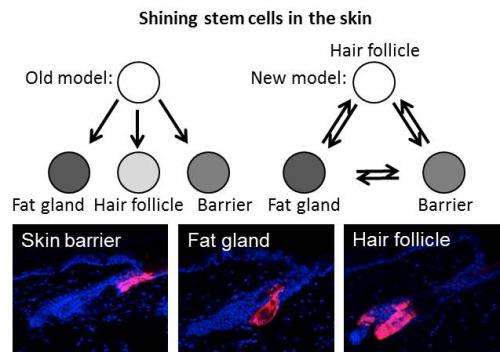Shining stem cells reveals how our skin is maintained

All organs in our body rely on stem cells in order to maintain their function. The skin is our largest organ and forms a shield against the environment. New research results from BRIC, University of Copenhagen and Cambridge University, challenge current stem cell models and explains how the skin is maintained throughout life. The results have just been published in the recognized journal Cell Stem Cell.
New knowledge challenge stem cell models
The skin consists of many different cell types, including hair cells, fat- and sweat glands. It protects us against microbial and chemical attacks and forms a waterproof barrier that prevents fluid loss. Associate professor Kim Jensen' group from BRIC have through mapping of stem cell's behaviour in the skin found out that the skin uses a unique method to renew itself. Their results challenge the current perception of how our skin is renewed.
"Until now, the belief was that the skin's stem cells were organized in a strict hierarchy with a primitive stem cell type at the top of the hierarchy, and that this cell gave rise to all other cell types of the skin. However, our results show that there are differentiated levels of stem cells and that it is their close micro-environment that determines whether they make hair follicles, fat- or sweat glands, says Kim Jensen.
The new research from Kim Jensen completes the stem cell puzzle.
"Our data completes what is already known about the skin and its maintenance. Researchers have until now tried to fit their results into the old model for skin maintenance.
However, the results give much more meaning when we relate them to the new model that our research proposes, says Kim Jensen.
One such example is that it explains the current mystery of how skin cells can divide too much and initiate a skin cancer, without any traces of genetic change in the stem cells believed to maintain the outer layer of the skin. The research from the Jensen group may suggest that the reason that no changes can be found is, that these cells do not take part in the over-proliferation at all.
New knowledge of skin cancer and wound healing
Kim Jensen's research group has used a unique method based on new technology, to understand how the skin is maintained.
"We have marked the early skin stem cell with shining proteins in order to map stem cell behaviour in the outer layer of the skin. The stain is inherited by the daughter cells, so that we can trace their origin and make a family tree. The fine details of the family tree can be used to infer the stem cell's role in normal maintenance of the skin, as well as in wound healing, says Kim Jensen.
An important function of stem cells is to repair damaged tissue. Here, the results from the Jensen groups show that the different stem cell populations collaborate across their normal functions, to repair the skin as fast as possible. However, this can also cause harm, as these changes can "wake up" genes in the stem cells and give rise to cancer. The new results consequently also contribute with new knowledge on the origin of skin cancer.
"Our research will now take two directions. We will establish mathematical models for organ maintenance in order to "measure" what stem cells are doing in the skin. Also, we will expand our investigations in cancer initiation, hoping for results that can contribute to cancer diagnostics and improved treatment, says Kim Jensen.
More information: "The Epidermis Comprises Autonomous Compartments Maintained by Distinct Stem Cell Populations." Page et al Cell Stem Cell, advanced online publication on August 15, 2013.
Journal information: Cell Stem Cell
Provided by University of Copenhagen
















